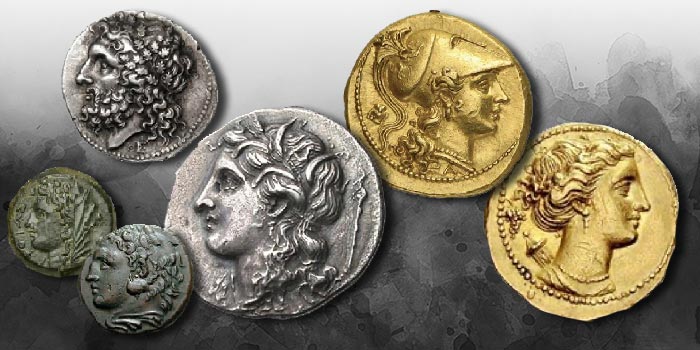
By Mike Markowitz for CoinWeek …..
EPIRUS IS A rugged corner of northwestern Greece and southern Albania. It emerged as an independent kingdom in the fourth century BCE, a time when other contemporary Greeks regarded the region’s tribes as “semi-barbarian”. About 319 BCE a prince of Epirus was born, named Pyrrhus, whose father was a cousin of Alexander the Great’s ferocious mother, Olympias.
In ancient Greece, as in modern Europe, a prince’s education trained him in a few essential skills: hunting, riding, soldiering, and being charming. Handsome and athletic, Pyrrhus put these skills to good use in an adventurous career. He became king at the age of 13 but was deposed by a palace coup four years later. He found refuge at the Macedonian court of his brother-in-law, Demetrius “The Besieger”[1]. He fought bravely beside Demetrius, who was defeated at the great Battle of Ipsus (301 BCE). Welcomed in Egypt at the brilliant court of Ptolemy I, he married a princess and was given a fleet, mercenaries, and funding to regain his kingdom. In 280 BCE the Greek city of Tarentum in southern Italy, at war with Rome, invited Pyrrhus to intervene. With an army of 25,000 troops and 20 war elephants (never before seen in the Italian peninsula), he set out on a mission of conquest, hoping to emulate his kinsman and role model, Alexander the Great.
After the particularly bloody Battle of Asculum in 279 BCE, Pyrrhus famously remarked: “If we are victorious in one more battle with the Romans, we shall be utterly ruined.” This is the origin of the phrase “Pyrrhic victory”.
The coinage of Pyrrhus is complex. Most cities he occupied continued to strike their traditional designs. These are generally catalogued with a phrase like “time of Pyrrhus”. For types inscribed ΒΑΣΙΛΕΩΣ ΠΥΡΡΟΥ (“of King Pyrrhus“), the mint is often uncertain, some were struck in Italy, others back in Epirus. Although his peers, the other Hellenistic kings, were proudly placing their own portraits on coinage, Pyrrhus never did. His coins all bear the images of gods and goddesses. Our picture of his appearance comes from Roman copies of idealized Greek sculptures made long after his death.
Tetradrachm
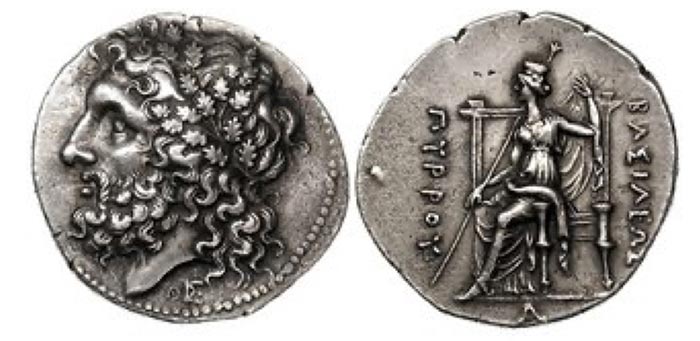
This coin is a masterpiece of early Hellenistic art. The head of Zeus is one of the most magisterial ever to appear on a coin. The dynamic elements of the flowing hair and beard provide the obverse with great power and beauty, while the reverse type, depicting Dione enthroned in full drapery, is reminiscent of Hellenistic sculpture. The style and execution of this issue are superior to anything else of the time[2].
The silver tetradrachm, a flashy, high-value coin (think of it as the ancient equivalent of a $20 bill), was struck with dies engraved by the most talented artisans. The tetradrachm of Pyrrhus depicts Zeus of Dodona, the most sacred site in Epirus, where the god’s oracle was located in a grove of oaks. Zeus wears a wreath of oak leaves. The reverse bears an elegant figure of the earth goddess Dione, mother of Aphrodite. A recent study found 61 known examples of this coin and estimated that only about 100 exist (Tsoukanelis, 20). One of the finest known examples brought $120,000 USD in a 2011 New York sale[3].
Octobol
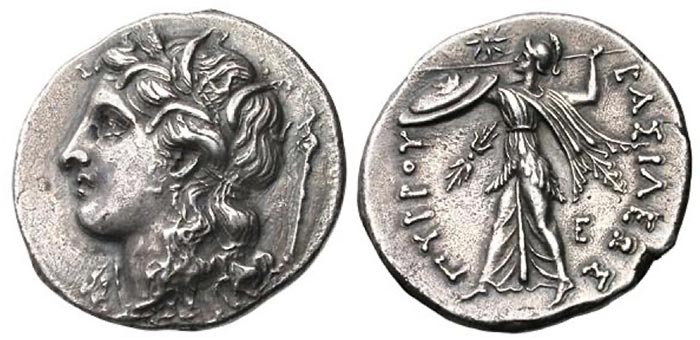
The silver octobol, or eight-obol piece, is an uncommon denomination (six obols equaled one drachma). Weighing about 5.6 grams, the octobol in the name of Pyrrhus was issued at Syracuse during his brief reign as king of Sicily (278-276 BCE)[4]. The obverse bears the youthful head of Kore (another name for the goddess Persephone) with her emblematic wreath of wheat ears. The reverse depicts the war goddess, Athena, closely copying a coin of Pyrrhus’s patron, Ptolemy I.
Didrachm
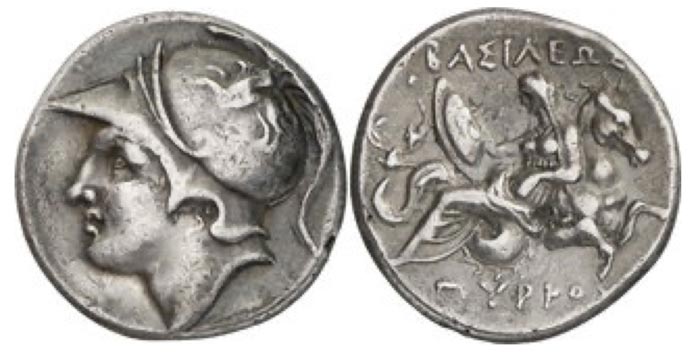
A rare silver didrachm[5] (8.2 grams) from the unpronounceable city of Lokroi Epizephyrioi (now Locri, Italy) celebrates Pyrrhus’s claimed descent from the mythical hero Achilles. The obverse is a helmeted head of Achilles. The reverse shows the sea nymph Thetis, mother of Achilles, riding on a sea-horse (hippocamp) gazing backward at the hero’s magical shield[6], forged at her request by the god Hephaestus.
Half Stater
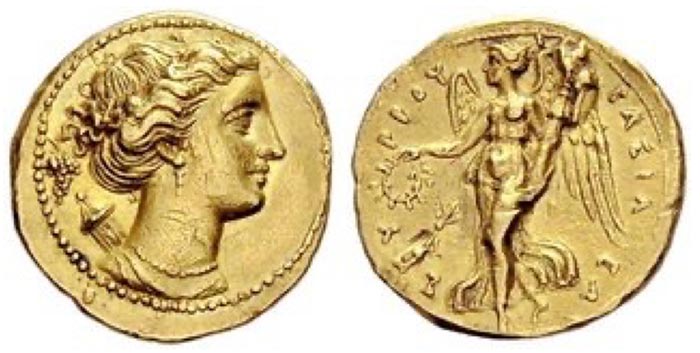
To pay mercenaries needed to fight the Carthaginians, Pyrrhus produced a massive issue of gold staters and half staters at Syracuse. The finest engravers were hired to produce stunning designs as Syracuse took pride in its coinage. A superb example of this coin was in the famous William Herbert Hunt collection. The cataloguer gushes:
Its types are those of the gold staters of Alexander the Great … The style of these staters however is far more refined … and demonstrates the irrepressible eroticism of West Greek art … In contrast to the pudgy asexual Athena of the Alexandrine staters, Pyrrhus’ coin presents an extremely elegant and beautiful woman who almost looks out of place in a helmet … The heavy-lidded eyes and full, slightly parted lips belong more to the iconography of Aphrodite than Athena.
The Nike figure on the reverse is even further removed from the Alexandrine prototype. This Nike literally dances where the other stands still… (Kimball, 214).

Despite a small scuff on Athena’s cheek, an example of this coin brought $180,000 in a 2012 New York auction[7]. A half-stater, bearing the head of Artemis rather than Athena, brought over $37,000 in a 2013 European auction[8].
Bronze
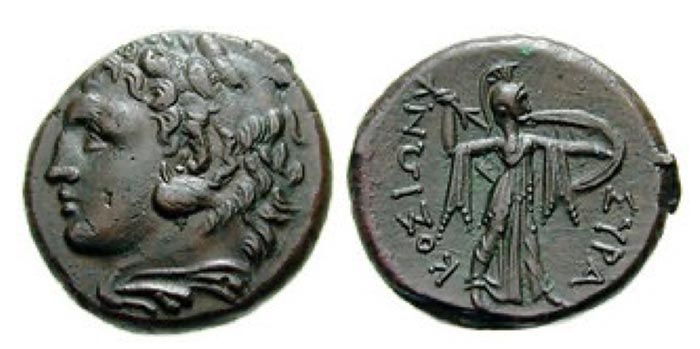
Syracuse had a long tradition of abundant bronze small change valued at one, one-half, one-third, and one-quarter litra (the litra being a local unit). High-grade examples in the name of Pyrrhus are surprisingly affordable[9].
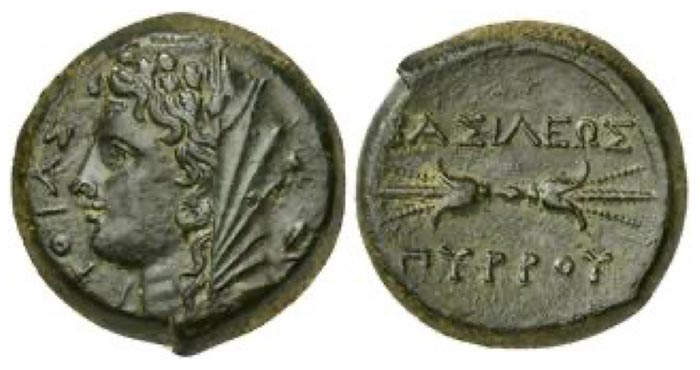
When the Sicilians grew tired of the high taxes Pyrrhus imposed, they drove him out. After another costly, indecisive clash with the Romans at Beneventum (275 BCE), Pyrrhus returned to Epirus. He provoked a conflict with Sparta and died in a street battle in Argos when he was struck on the head by a roof tile hurled by an old woman (272 BCE).
When Hannibal[10] (c. 247-181 BCE), who knew something about generalship, was asked who was the greatest general of all time he replied “either Alexander or Pyrrhus, then myself.”
* * *
Notes
[1] https://en.wikipedia.org/wiki/Demetrius_I_of_Macedon
[2] New York Sale XXVII, January 4, 2012, Lot 340. Realized $60,000 USD.
[3] Freeman & Sear, Manhattan Sale II, January 4 2011, Lot 56. Realized $120,000 USD (estimate $60,000).
[4] Gemini III, January 9, 2007, Lot 78. Realized $2,200 USD (estimate $2,000).
[5] New York Sale XXVII, January 4, 2012, Lot 341. Realized $25,000 USD (estimate $9,500).
[6] https://en.wikipedia.org/wiki/Shield_of_Achilles
[7] New York Sale XXVII, January 4, 2012, Lot 342. Realized $180,000 USD (estimate $40,000).
[8] Sincona Auction 10, May 27, 2013, Lot 39. Realized CHF 36,000 (about $37,469 USD; estimate CHF 7,500).
[9] CNG Triton V, January 15, 2002, Lot 264 – Realized $250 USD (estimate $200);
Bertolami Fine Arts Auction 67, July 11, 2019, Lot 185 – Realized £240 (about $301 USD; estimate £150).
[10] https://en.wikipedia.org/wiki/Hannibal
References
Borba Florenzano, Maria. “The Coinage of Pyrrhus in Sicily: Evidence of a Political Project”, The Age of Pyrrhus (Tony Hackens, editor). Providence, RI (1992)
Dryden, John (translator). Plutarch’s Lives. New York (1975)
Kimball Art Museum. Wealth of the Ancient World. Fort Worth, TX (1983)
Lualdi, Carlo. “A Coined Victory of Pyrrhus: The Propagandistic Iconography on the Gold Staters of Pyrrhus in His Sicilian Coinage, An interpretative Proposal”, Conference Proceedings of the Second International Numismatic Conference. Krakow (2017)
Tsoukanelis, Simon. “The Tetradrachms of Pyrrhus: A Preliminary Die Study”, Celator 24 (May 2010)




